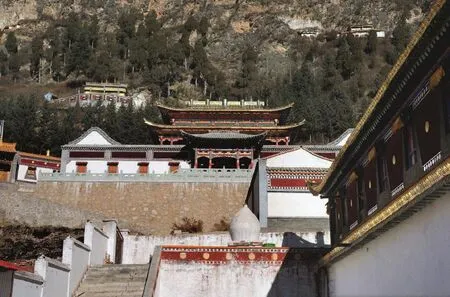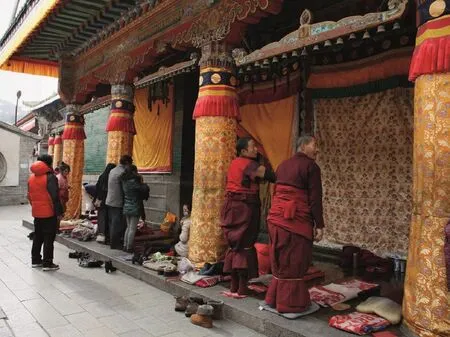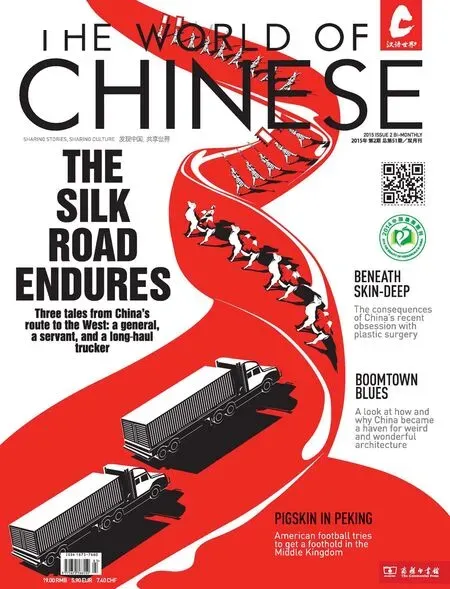DONNING THE YELLOW HAT
DONNING THE YELLOW HAT
On the trail of the Catholic missionaries who sought Buddhist enlightenment
跟隨19世紀法國傳教士的游記,踏上一段輾轉的青海之旅
TEXT & PHOTOGRAPHS BY KATHARlN TAl
When two Catholic missionaries from France passed through what is now China’s Qinghai Province in 1845, their impression was anything but favorable: “The county of Amdo is sad and savage. The eye doesn’t fall upon anything but red and yellow mountains, nearly without any vegetation, furrowed by deep, dry channels.” They probably came through this dusty county during winter, just as we did, and their words rang true when I looked out of the train window on our way to Xining. For all the money being poured into the high-rise apartment buildings, the as-yet uninhabited skeletons of which you can see from the train and bus windows, the winter air around Qinghai’s capital Xining, together with the dry, dusty yet chilly nights—at below negative ten degrees Celsius—made me doubt my decision to come here more than once.
But, like the two Frenchmen, évariste Régis Huc and Joseph Gabet, who came here more than 150 years ago, we hadn’t come to Qinghai for its pleasant climate. Starting at the French embassy in Beijing, they were on their way to Lhasa but stayed for three months in Kumbum (塔爾寺), one of Qinghai’s monasteries, to study the Tibetan language and religion. Huc in particular was fascinated by religion in China in general, especially Buddhism, and Qinghai was a good place to start. As godforsaken and deserted as the land seems at frst sight, green pastures with grazing yaks are hidden between the dry mountains, and their Tibetan owners follow centuries-old religious traditions. While the meadows are oases for yaks and nomads, Qinghai’s monasteries offer refuge of the spiritual kind.
Amdo is home to the Gelug Sect of Buddhism, perhaps better known as the Yellow Hat Sect,the most recent and infuential school of Buddhism. It was founded in the late 14th century and Huc and Gabet were not the only ones who came to Amdo to study it—the Belgian explorer Alexandra David-Néel actually spent three years at Kumbum Monastery from 1918 to 1921. We wanted to see what had become of the places described in these accounts from almost a hundred years ago.
Kumbum Monastery was our frst stop, about a onehour bus drive from Xining up a mountain through winding roads and past a giant frozen lake. Of course the bus door didn’t close properly, so it was freezing cold, and the persistent rattling of metal against glass made me wonder if we wouldn’t have been better off taking mules up to the monastery as Huc and Gabet had in 1845.
Kumbum isn’t just any monastery—it was built where the founder of the Gelug Sect, Tsongkhapa, had been conceived in the 14th century. His parents were Tibetan nomads, who put up their black tent both in Amdo’s green summer hills and its dusty and dry ones in winter. According to the legend, they were grazing their animals, about 20 goats and a few yaks, around where Kumbum is located today, when Tsongkhapa’s mother fell. She stumbled over a rock with holy characters praising Buddha carved into the surface and realized that she was pregnant after she had stood up from her fall. She later went on to build a small temple where she had given birth to Tsongkhapa in the 1350s, and the modest institution was turned into a monastery in the 16th century.
NOWADAYS, THE ONLY MONGOLlANS PASSlNG THROUGH KUMBUM ARE PROBABLY TOURlSTS
It is located on the fank of a hill next to a small town. The hills surrounding the monastery have a few leafess trees and colorful prayer fags cowering from the cold wind. On one side, the monastery is crawling up the mountain with its red, black and white buildings. Maybe this is where Alexandra David-Néel lived among the mountains when she studied Buddhism at Kumbum in the 1920s. The place she saw was probably still quite similar to the one where Tsongkhapa’s mother stumbled across the stone—in her accounts, David-Néel describes how she looked across the monastery from her balcony:“I had grown accustomed to contemplate the golden roofs of the temples and, beyond them, the grassy slopes where grazed shaggy yaks and the stately camels of the Mongolian caravans.”
While the yellow earth that lay between our feet and the sun that shone in the winter sky above Kumbum were still the ones David-Néel saw, much has changed in the past 90 years. Nowadays, the only Mongolians passing through Kumbum are probably tourists, and while Tibetan nomads still live in Qinghai, it’s hard to imagine them around Kumbum. The town next to the monastery has shopping streets with stores blasting out dance music at the highest volume and visitors to the monastery are thrown out of the bus at a traffc junction between butchers and bakeries.
To actually get to Kumbum, travelers walk up a small slope, along a broad street lined with identical looking shops—red walls, black doors. The few that are open in the off-season sell prayer fags and Buddhist statues, but they aren’t quite as eager to sell their goods to the two foreign tourists as the vendors waiting right outside Kumbum’s main gate. Incense, plants to burn, prayer fags? They got you covered.
But upon entering the monastery’s main courtyard with several white stupas, we realized that, perhaps, the forgotten time when Tsongkhapa’s parents had their yaks graze the hills was still alive. The solitude David-Néel and the two Frenchmen wrote about is gone, but the whole area is flled with Tibetan pilgrims, who keep alive the traditions introduced by the son of a nomad almost 700 years ago.
Right next to the stupas in Kumbum’s courtyard, a woman of at least 70 years was prostrating herself, seemingly endlessly: Stand up, hold your hands above your head, kneel down, lie down, put your hands on the ground in front of you—and then get back up to start over. The Han Chinese tourists seemed to be as fascinated by her as we were and stared at her openly. Apart from the old woman, the courtyard and the countless small temples we saw were full of Tibetans with sunburned faces, most of them with children. Many of them didn’t speak Chinese and seemed to come from more remote Tibetan areas in Qinghai and other provinces.

The silence of Youning Monastery seems like a world away from Kumbum's noisy streets

A young monk welcomes visitors with a smart phone concealed in his sleeve
We were already cold with our three layers of clothes and I sometimes envied the pilgrims their traditional Tibetan coats: about knee-long, white fur on the inside and two long sleeves, of which only the left one was worn while the other was fxed on the back with a broad belt. It’s probably the best way to dress if you live on Qinghai’s high plateau, where temperatures in winter drop way below zero degrees Celsius.
The pilgrims easily outnumbered the tourists, but in the off-season the monks didn’t even bother to sell the tickets that normally go for 80 RMB a piece. One of them assured me that in summer tourists and foreigners were “very many, very many”, while he was sitting in one of the butter-candle lit temples and tried to coax the son of a tourist couple into telling him how old he was. With all its small temples and halls, Kumbum seems more like a village than like a monastery, and we easily spent four hours exploring the halls with endless rows of golden Buddha statues and courtyards with small stone ovens and prayer wheels. Once we entered any of the halls, what had been uncomfortable became a bone-chilling cold, as the concrete walls effectively kept out all the sunlight. Instead, we were enveloped by the pervasive and soon familiar smell of candles kept afame by yak butter.

Pilgrims prepare to enter the temple

Prayer wheels are a common sight in these temples
The polished, shining traces left in the stone foor told the story of many, many bows over a very long time.
Our mere presence drew the attention of a few children, imitating the grown-ups or running around behind them, and a young monk of around 20 years old. He stood in front of one of the pilgrims and every time he fnished one round, the monk clicked a small, yellow counter on his right index fnger. As with almost everyone else, he looked at us curiously, and we took the opportunity to strike up a conversation with him. Our most important question:“Just how often did the visitors bow down in front of the temples?” He answered: “100,000 times”.
“For younger people like you or me, it takes about three months,” he explained, “but the older ones might need half a year.” He spoke calmly, with a soft Amdo-Tibetan accent in his Chinese, and when he saw my disbelief, he showed a cheeky smile that didn’t quite beft my image of a monk. “It’s not a requirement for followers of Buddhism,” he continued. “It’s more like a question of your personal belief if you want to do the 100,000 bows or not. Once they’ve decided to do it, they come here, rent a room, buy food by themselves, and come here every day.”
I looked at the dozen or so Tibetans in front of the hall again, differently this time. It felt strange to see this kind of devotion in China, where most temple visits I had witnessed seemed to be of a much, much shorter nature and be closer to one hour than half a year. Before we left, I asked the monk how many of the bows he had already done. The answer? A mere 30,000.
As impressive as Kumbum was, little could be felt of the serenity Alexandra David-Néel had described upon leaving the monastery in 1921: “The mind experienced to the point intoxication, the subtle voluptuousness of solitude and silence.”
Alas, our search for the remnants of Tsongkhapa’s beliefs in his home country didn’t stop at his birthplace. Rather, just as David-Néel, we left the monastery—even if our goal wasn’t Lhasa and we didn’t get into a fght with Mongolian Caravans along the road about who would get to pass frst. Instead, we had to avoid yaks and motor bikes on dusty mountain roads after boarding another bus in Pingan, close to Xining.
This time, we were bound for Youning Monastery (佑寧寺), known as G?nlung in Tibetan—a far less famous Gelug Sect institution from 1604, that took three hours instead of one to reach. Maybe that’s why neither Huc and his partner nor David-Néel made it there and settled for Kumbum instead; for anyone traveling on mules, G?nlung must have been impossibly far away from the main road passing through Xining.
Pingan is more of a village turned local transport hub—the frst bus from Xining just let us out at an intersection and told us to head for the blue minibuses next to several clementine sellers. The settlements we passed from there on only got smaller, and most of them seemed to consist of several one or two-storeyed buildings lined up along the main road, many of them made of clay. Every village had at least one house in front of which old men in black jackets congregated to sit on wooden stools, smoke, and watch the road. Ocherred mountains and an almost perfect blue sky made for an incredible backdrop.
G?nlung sits in the middle of the Tu Autonomous County of Huzhu, hosting a minority originally from Inner Mongolia, at an elevation of almost 3,000 meters above sea level—which we noticed when we got out of the bus and were almost immediately out of breath. Walking up a gravel road to the monastery, we passed a stone on which was written the Chinese characters for“harmony” and we had to bend our necks back to see the tops of the huge snow-capped mountains towering behind the monastery. There was still snow on both sides of the street, but the sun was getting as ferce as it does at this altitude and I was pretty sure after a few minutes that we’d get back to Xining with a sunburn in the evening.
G?nlung is signifcantly smaller than Kumbum and instead of having a huge courtyard, the monastery just seems to have grown out of or into the adjoining village. One moment, the buildings on the left of the road were small stores and an improvised bus stop, the next, we passed one of the main halls of the monastery. While we curiously looked at the locals walking around the hall, one of the monks was at least as interested in us and took a smart phone out of his red sleeve to snap a picture of the two visitors.
We wanted to talk to him, but while he was still taking pictures, the constant chanting that had been going on inside the hall stopped and he stumbled to run inside. While the monastery houses about 300 monks, we saw maybe a dozen of them, most of them lingering around the monastery in pairs and watching the few local pilgrims. Just like Kumbum, G?nlung’s buildings seem to slowly crawl up the slope of the mountain, but they don’t cover it. Instead, they became fewer and fewer as we went further up, fghting with the thin air until we fnally found ourselves on a small trail through thorny bushes.
The trail led further away from the monastery’s buildings, toward a small ledge that was home only to several ropes with prayer fags and offered an amazing view of the valley and the village below. Colorful pieces of paper with mantras written on them and burnt out fres told the stories of other people who had been here to pray. But right now, the only thing we could hear was the noise of the fags futtering in the wind. Once it stopped, the silence over G?nlung seemed absolute, neither people nor animals could be heard. Maybe this was the serenity that Alexandra David-Néel had loved so much about Kumbum. It certainly made my mind feel a calmness that might be necessary for following and studying Tsongkhapa’s thoughts from seven centuries ago.

